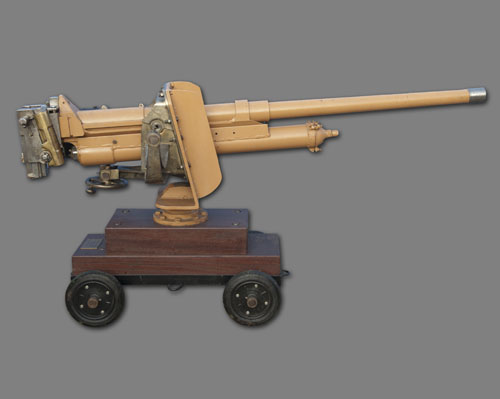Product Details
A BRITISH 2pdr Q/F ANTI-TANK GUN, MODEL MK XA, no visible serial number,
dated for 1942, with 78 3/4in. barrel, semi-automatic opening breech, small shield for vehicle use, fully restored condition TOGETHER WITH a later wheeled teak-wood display trolley bearing a brass plaque engraved ' BRITISH 2-PR Q/F TANK ANTI/TANK ARTILLERY MKX1-XA 1942'
Provenance: The Ordnance QF 2-pounder (or simply "2 pounder gun") was a 40 mm (1.575 in) British anti-tank and vehicle-mounted gun, employed in the Second World War. It was actively used in the Battle of France, and during the North Africa campaign. As tanks became sufficiently armoured to stand up to its shots, it was gradually replaced by the 6-pounder, starting in 1942, though some remained in service until the end of the war. In its vehicle-mounted variant, the 2-pounder was also a common main gun on British tanks early in World War II, and was a typical main armament of armoured cars such as the Daimler throughout the war.
The gun was initially developed as a tank weapon, and made its debut as the main armament of the Vickers-designed Cruiser Tank Mk I. For reasons of economy and standardisation, the Director of Artillery accepted it as a basis for an anti-tank gun in October 1934. Contracts to design a carriage were given to Vickers and the Woolwich Arsenal. Vickers was the first to submit a design, which was accepted as the Ordnance QF 2-pounder Mark IX on Carriage Mark I. A limited number of pieces were built in 1936. The carriage had an innovative three-legged construction. In the traveling position, one of the legs was used as a towing trail, and the other two were folded. When the gun was positioned for combat, the legs were emplaced on the ground and the wheels were lifted up. Woolwich Arsenal's carriage was found to be cheaper and easier to produce than the Vickers design, and with the gun was adopted as Ordnance QF 2-pounder Mark IX on Carriage Mark II. It was conceptually similar, although when the gun was emplaced for combat the wheels had to be removed. This carriage was also manufactured by Vickers.
The unusual construction gave the gun good stability and a traverse of 360 degrees, allowing it to quickly engage moving vehicles from any approach. With the Vickers carriage, the gun could also be fired from its wheels, at the expense of limited traverse. The 40 mm 2-pounder could outperform a typical 37mm piece such as the German 3.7 cm PaK 36 or the Bofors 37 mm, and hugely outclassed the smaller 25 mm and 20 mm weapons used by some forces. On the negative side, the 2-pounder was nearly twice as heavy as PaK 36, and had a higher profile.
One interesting late-war project was the David High Velocity, a Canadian development that allowed 2-pdr ammunition to be fired from the larger-calibre 6-pdr. This was intended to improve the muzzle velocity of the shot. The system was still being developed when the war ended, the program ending along with it.
One of the most serious shortcomings of the 2-pdr was the lack of a high explosive shell. Especially if the 2-pdr was the main gun of a tank, which was a very important item when a tank was being used in the infantry support role having only its machine gun to rely on. A high explosive shell was designed for the 2-pdr but was never placed in production.
The particular gun presented here was removed from a Marmon-Herrington Armoured Car in 1994. This actual vehicle saw action against the Afrika Korps in the Western Desert and was present at El Alamein.
Other Notes: Please Note: This item requires a UK section 1 firearms licence
Estimate £3,000-5,000
S1

